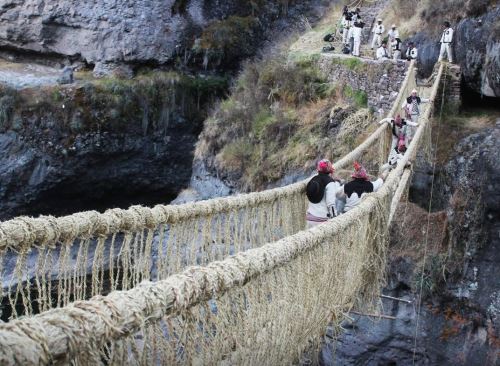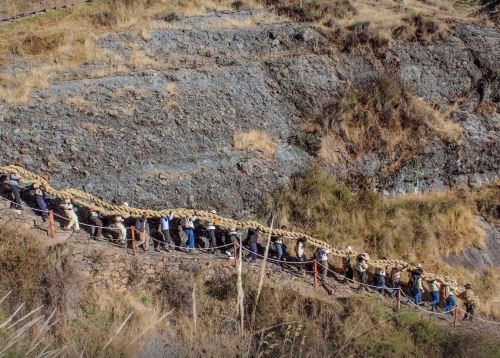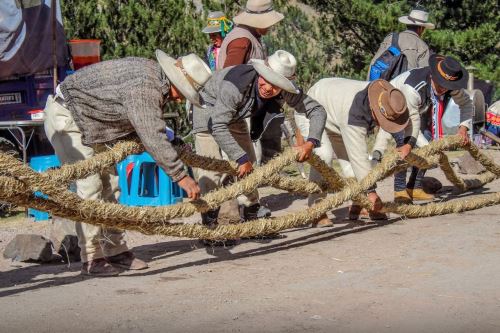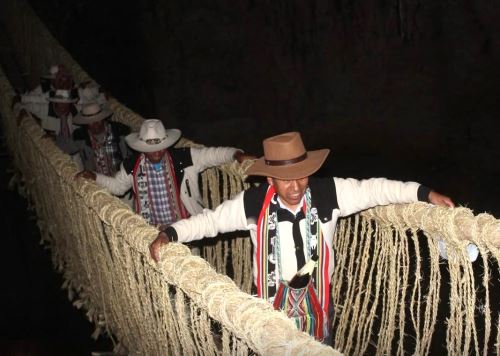Peru's: Q'eswachaka Bridge in Cusco can now be visited by tourists after ancestral renewal

The emblematic Q'eswachaka —the "last Inca bridge"— is now open for visits by locals, people from Cusco, and tourists, following the reconstruction and renewal carried out last week by community members —heirs to ancestral techniques and guardians of the legacy.




Published: 6/10/2025
The inhabitants of Huinchiri, Chaupibanda, Choccayro, Perccaro, Chiripampa, and Collana Quehue, from Quehue district, Canas province —who on May 17 expressed their outrage over the attack on the bridge, after cuts were found near the abutments— came together and made a commitment.

By June 5, they had gathered ichu (straw), stalks of native species, and cattle hide.
After performing Andean thanksgiving ceremonies, they invoked the Pachamama (Mother Earth) and the Apus (Sacred Mountains) to carry out the ancestral renewal that vindicates them.
Faithful to their protocols, the authorities, leaders, and organizers of the 2025 Q'eswachaka Folkloric Festival held a dance and traditional music competition, sharing moments of joy and traditional local food.
Quehue Mayor Walter Oroche Quispe highlighted the work carried out over the past week, as well as the wisdom of community members —inherited from their ancestors and preserved to this day— which led to recognition by UNESCO as Intangible Cultural Heritage of Humanity in 2013.

"UNESCO recognizes that wisdom of the people, not so much the material aspect. Every person who lives here is (part of our) heritage," he said, noting that Q'eswachaka is one of the heritage sites, along with the Qhapaq Ñan, the Señor de Exaltacion Temple, Chiaraje, and the vicuña reserve —all of which are also recognized as heritage.
Technical roundtable and investigation
After the attack suffered three weeks ago, local and regional authorities confirmed the formation of a technical roundtable to coordinate strategies for the care of the Q'eswachaka Bridge, with participation from the Cusco Directorate of Culture.
The institution's Director Jorge Moya confirmed the urgency of preserving, conserving, and safeguarding the legacy.
"We are going to hold a technical roundtable with them (the communities). That is why our team is here, not only from Intangible Cultural Heritage, but also from Interculturality (office) to address the issue of awareness-raising," he said.
Regarding progress in the investigation into those responsible for the bridge attack, the director stated that the Public Ministry is continuing the inquiries, but so far, it remains unknown who was responsible for cutting the bridge.
Moya also mentioned that this is the first time an attack has been carried out against intangible heritage and that, in addition to a technical report, a dossier on interculturality and intangible cultural heritage is being prepared as well.

"It should be emphasized that this bridge was under the care of the communities because it lies within their territory. We are going to work on awareness-raising and propose a constant monitoring plan, since I had knowledge that there has been a guard. Now we must consider whether we will assign a guard as well," Moya concluded.

(END) PHS/MAO/JMP/MVB
Published: 6/10/2025
Most read
-
La Libertad: hallan sin vida a enfermera que ayudó en tragedia del Real Plaza de Trujillo
-
Universitario golea 5-0 a ADT y se afianza en la Liga 1
-
Ministerio de Educación separó a 889 docentes por delitos de violación, terrorismo y otros
-
CADE Universitario 2025: becarios de Pronabec participarán por primera vez en evento
-
Gobierno avanza con proyectos para garantizar gas natural en el Cusco
-
35 estudiantes peruanos viajarán a Europa para cursar maestrías con becas Erasmus Mundus
-
Editora Perú es reconocida por INSN-San Borja como aliada de la salud infantil [video]
-
¿Usas motocicleta? Cascos y chalecos deben tener estas especificaciones técnicas
-
BCR: déficit fiscal seguirá bajando hasta 2.5% del PBI este año y 2.1% en 2026
-
Exportaciones peruanas de jugos crecerían hasta US$ 9 millones en 2028